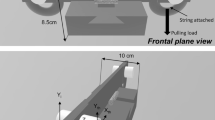Abstract
The adaptation of the grip forces to the frictional condition between the digits and an object relies on feedforward sensorimotor mechanisms that use tactile afferent input to intermittently update a sensorimotor memory that controls the force coordination, i.e., the ratio between grip force (normal to the grip surface) and load force (tangential to the grip surface). The present study addressed the development of these mechanisms. Eighty-nine children and 15 adults lifted an instrumented object with exchangeable grip surfaces measuring the grip and load forces. Particularly in trials with high friction (sandpaper), the youngest children used a high grip force to load force ratio. Although this large safety margin against slips indicated an immature capacity to adapt to the frictional condition, higher grip forces were produced for more slippery material (silk versus sandpaper). The safety margin decreased during the first 5 years of age, in parallel with a lower variability in the grip force and a better adaptation to the current frictional condition. The youngest children (18 months) could adapt the grip force to load force ratio to the frictional condition in a series of lifts when the same surface structure was presented in blocks of trials, but failed when the surface structure was unpredictably changed between subsequent lifts. The need for repetitive presentation suggests a poor capacity to form a sensorimotor memory representation of the friction or an immature capacity to control the employed ratio from this representation. The memory effects, reflected by the influences of the frictional condition in the previous trial, gradually increased with age. Older children required a few lifts and adults only one lift to update their force coordination to a new friction. Hence, the present finding suggests that young children use excessive grip force, a strategy to avoid frictional slips, to compensate for an immature tactile control of the precision grip.
Similar content being viewed by others
References
Cole KJ (1991) Grasp force control in older adults. J Mot Behav 23:251–258
Cole KJ, Johansson RS (1993) Friction at the digit-object interface scales the sensorimotor transformation for grip response to pulling load. Exp Brain Res 95:523–532
Cordo PJ, Flanders M (1989) Sensory control of target acquisition. Trends Neurosci 12:110–117
Edin BB, Westling G, Johansson RS (1992) Independent control of human finger-tip forces at individual digits during precision lifting. J Physiol (Lond) 450:547–564
Eliasson AC, Gordon AM, Forssberg H (1991) Basic coordination of manipulative forces in children with cerebral palsy. Dev Med Child Neurol 33:659–658
Eliasson AC, Gordon AM, Forssberg H (1995) Tactile control of isometric finger forces during grasping in children with cerebral palsy. Dev Med Child Neurol 37:56–71
Espinoza E, Smith AM (1990) Purkinje cell simple spike activity during grasping and lifting objects of different textures and weights. J Neurophysiol 64:698–714
Evans AL, Harrison LM, Stephens JA (1990) Maturation of the cutaneomuscular reflex recorded from the first dorsal interosseous muscle in man. J Physiol (Lond) 428:425–440
Forssberg H, Eliasson AC, Kinoshita H, Johansson RS, Westling G (1991) Development of human precision grip. I. Basic coordination of force. Exp Brain Res 85:451–457
Forssberg H, Kinoshita H, Eliasson AC, Johansson RS, Westling G, Gordon AM (1992) Development of human precision grip. II. Anticipatory control of isometric forces targeted for object's weight. Exp Brain Res 90:393–398
Gordon AM, Forssberg H, Johansson RS, Westling G (1991) Visual size cues in the programming of manipulative forces during precision grip. Exp Brain Res 83:477–482
Gordon AM, Forssberg H, Eliasson AC, Johansson RS, Westling G (1992) Development of human precision grip. III. Integration of visual size cues during the programming of isometric forces. Exp Brain Res 90:399–403
Gordon AM, Westling G, Cole K, Johansson RS (1993) Memory representations underlying motor commands used during manipulation of common and novel objects. J Neurophysiol 69:1789–1796
Gordon AM, Forssberg H, Iwasaki N (1994) Formation and lateralization of internal representations underlying motor commands during precision grip. Neuropsychologia 32:555–568
Hepp-Reymond M-C, Wannier TMJ, Maier MA, Rufener EA (1989) Sensorimotor cortical control of isometric force in the monkey. Prog Brain Res 451–463
Issler H, Stephens JA (1983) The maturation of cutaneous reflexes studied in the upper limb in man. J Physiol (Lond) 335:643–654
Jenner JR, Stephens JA (1982) Cutaneous reflex responses and their central nervous pathways studied in man. J Physiol (Lond) 333:405–419
Johansson RS, Cole KJ (1992) Sensory-motor coordination during grasping and manipulative actions. Curr Opin Neurobiol 2:815–823
Johansson RS, Cole KJ (1994) Grasp stability during manipulative actions. Can J Physiol Pharmacol 72:511–524
Johansson RS, Westling G (1984) Roles of glabrous skin receptors and sensorimotor memory in automatic control of precision grip when lifting rougher or more slippery objects. Exp Brain Res 56:550–564
Johansson RS, Westling G (1987) Signals in tactile afferents from the fingers eliciting adaptive motor responses during precision grip. Exp Brain Res 66:141–154
Johansson RS, Westling G (1988) Coordinated isometric muscle commands adequately and erroneously programmed for the weight during lifting task with precision grip. Exp Brain Res 71:59–71
Johansson RS, Westling G (1991) Afferent signals during manipulative tasks in man. In: Franzen O, Westman J (eds) Somatosensory mechanisms. Macmillan, London, pp 25–48
Rufener EA, Hepp-Reymond MC (1988) Muscle coactivation patterns in the precision grip. Adv Biosci 70:169–172
Picard N, Smith AM (1992) Primary motor cortical activity related to the weight and texture of grasped objects in the monkey. J Neurophysiol 68:1867–1881
Smith AM (1981) The coactivation of antagonist muscles. Can J Physiol Pharmacol 59:733–747
Wannier TMJ, Maier MA, Hepp-Reymond M (1991) Contrasting properties of monkey somatosensory and motor cortex neurons activated during the control of force in precision grip. J Neurophysiol 65:572–589
Westling G, Johansson RS (1984) Factors influencing the force control during precision grip. Exp Brain Res 53:277–284
Author information
Authors and Affiliations
Rights and permissions
About this article
Cite this article
Forssberg, H., Eliasson, A.C., Kinoshita, H. et al. Development of human precision grip. Exp Brain Res 104, 323–330 (1995). https://doi.org/10.1007/BF00242017
Received:
Accepted:
Issue Date:
DOI: https://doi.org/10.1007/BF00242017




